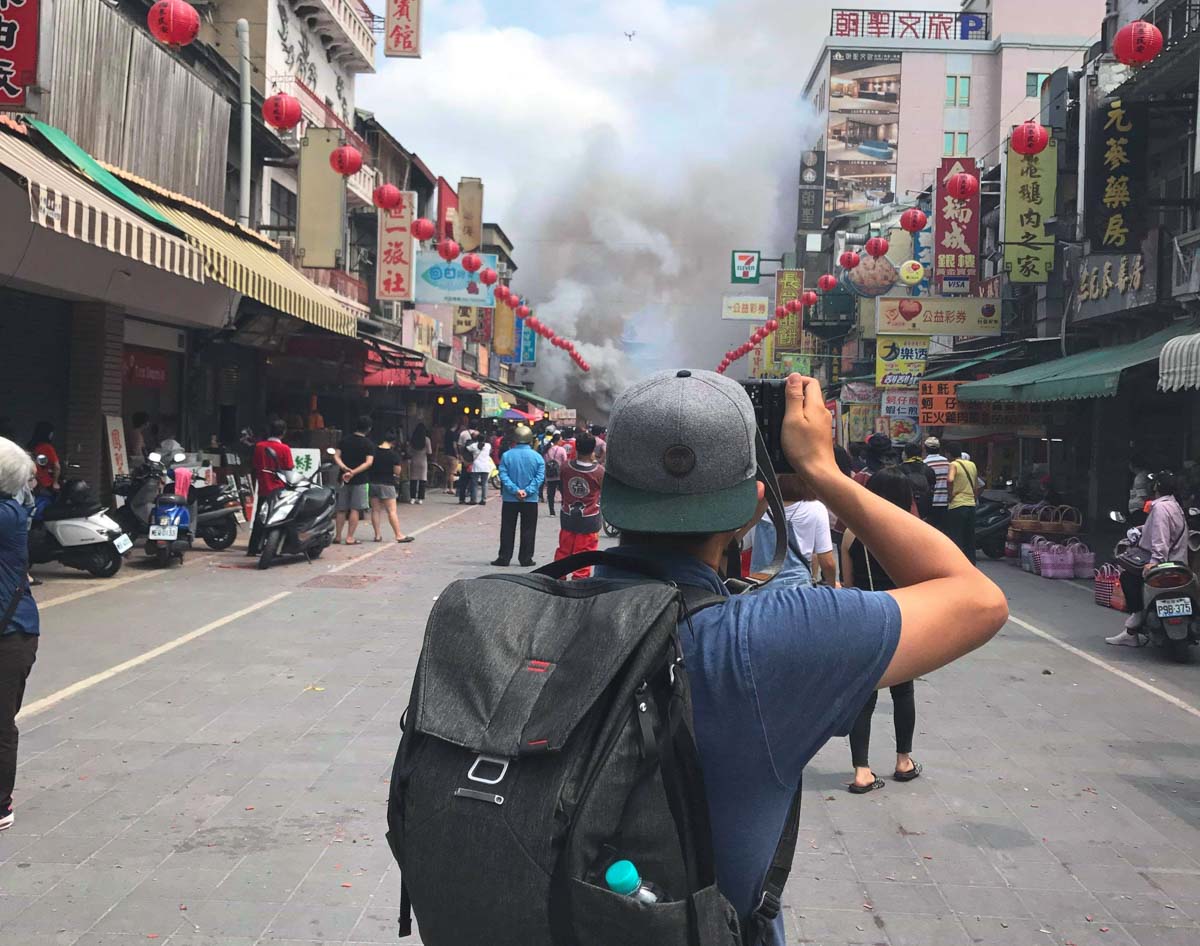If you’re in a hurry and just want to find out what the best slow-motion camera is, then I’d recommend the following
- Best Budget Slow Motion Camera: Sony a6400
- Best Mid-Range Camera: Panasonic GH5 or Fujifilm X-T4
- Best Premium/Full-Frame Slow Motion Camera: Sony a7 III or Panasonic S5
With camera technology advancements, the slow-motion capabilities of cameras nowadays are incredible. You can find budget cameras that can shoot in high quality 120 frames per second (FPS) in 1080p. There are even mirrorless cameras now that can shoot 60 FPS in 4k at 10-bit 4:2:2, which is mind-blowing considering just a few years ago these video specs were only available in professional cinema cameras.
What’s most important to remember when investing in camera gear is that creating interesting and cinematic videos is not because of the gear, it’s because of you, the filmmaker. A camera is a tool, and finding a camera that fits with your workflow can make it easier for you to achieve your vision.
Why Trust Me?
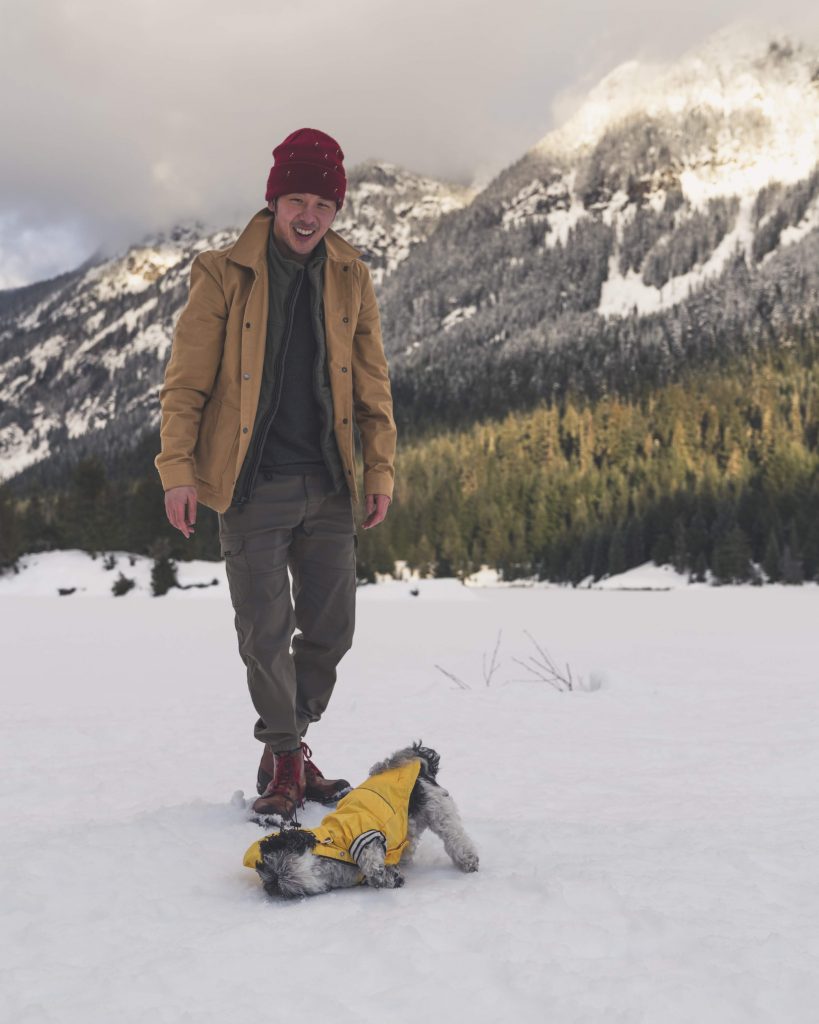
As with all of the Ultimate Guides I create, I have poured countless hours of research into this article to make sure you have all the information you need to make the best decision.
I have seen way too many camera articles that either don’t cover everything you need to know or they’re not updated frequently. Camera technology changes quickly, so to have the best information, you need the most updated information.
In my opinion, to truly understand what makes a good slow-motion camera, you need to have used them day in and day out in a variety of different situations.
I’ve been a professional filmmaker and photographer since 2018 and have been lucky enough to work on projects all over the world with brands such as Alaska Airlines, Kayak.com, Prague Tourism, Visa, Airbnb, and many more. If you’re curious to see the full list of companies we’ve worked with, just head over to our Work With Us page.
Being able to capture good slow-motion footage even in the most difficult of situations was one of the key factors in being able to execute my vision for my award-winning short film Spirit of Matsu.
From these experiences, I think I’m in a good position to help you find the perfect slow-motion camera for your filming workflow.
Most importantly, I’m just a message away. So, if you have any questions, just leave a comment below, email me at [email protected], or send me a DM on Instagram @tom.shu.
P.S. I answer every question that is sent 🙂
Reviews of the 10 Best Slow Motion Cameras

Here are my 10 favorite slow-motion cameras. To make it easier for you to find the right camera I have split them into 3 different categories based on price:
- Best Cheap Slow Motion Cameras
- Best Mid-Range Slow Motion Cameras
- Best Premium Slow Motion Cameras
Best Cheap Slow Motion Cameras

1. GoPro Hero9

Don’t overlook the GoPro Hero9! Yes, it’s primarily made as an action camera, but it has some incredible slow-motion specs. Add in the new HyperSmooth 3.0 technology with built-in horizon level technology, which is GoPro’s improved stabilization functionality and you have a very powerful camera capable of capturing some amazing slow-motion footage.
The GoPro Hero9 can shoot in 4k at up to 60 FPS and even in 2.7k at up to 120 FPS. It also has the ability to shoot in a High Frame Rate (HFR) mode of up to 240 FPS at 1080p. On the real-time frame rate side, the GoPro Hero9 is also the only camera in this article that can shoot in 5k resolution.
The biggest drawback of using an action camera is its small 1/2.3” sensor size and lack of lens flexibility. If you just shoot video casually these issues will be no problem at all, but if you’re creating professional work and need the flexibility that a mirrorless camera gives you, this might not be the best fit.
PROS
- New and improved HyperSmooth 3.0 stabilization technology with built-in horizon leveling technology.
- For slow-motion frame rates, it can shoot 4k up to 60 FPS, 120 FPS in 2.7k, and even 240 FPS in 1080p.
- The only camera in this article which is capable of shooting in 5k resolution.
- Time Warp feature allows you to easily shoot hyper lapses quickly which will add variety to your final video.
- Records at 60-100 Mb/s which is pretty good considering its price point and size.
- Has a detachable lens that allows you to easily replace lenses if you need to or add modes and ND filters.
- Uses a bigger battery that gives you 30% more battery life versus the previous generations of GoPro Cameras.
CONS
- Still an action camera so there is a lack of effective zoom for capturing other sports.
- The front-facing screen is a little choppy so you can only use it to preview your composition.
- For just a little more money you could purchase a mirrorless camera which would give you more flexibility when shooting.
- Older GoPro batteries are not compatible with this camera. So, if you have an older GoPro and are thinking about upgrading, you’ll have to buy new batteries.
2. DJI Pocket 2

The DJI Pocket 2 is DJI’s newest pocket gimbal and it improves on many of the popular and unpopular features of the original model. The newest additions make this one of the cheapest and best slow-motion cameras available.
Here are just some of the improvements that were made when compared to the older model:
- Ability to shoot in 1080p at up to 240 FPS. This is double the slow-motion frame rate of the previous generation.
- A wider 20mm equivalent lens vs the 26mm lens of the original camera.
- Larger 1./1.7-inch sensor vs the original 1/2.3 inch sensor.
- 64-megapixel photos vs 12-megapixels.
- Improved autofocus with Hybrid AF 2.0.
- Attachable mini control stick which gives more precise control.
- And many more…
Since the price of the base model of the DJI Pocket 2 and the original DJI Pocket Gimbal are so similar, it’s pretty much a no brainer to get this new version.
Now let’s dig deeper into what you get with the DJI Pocket 2 when it comes to slow-motion video.
For the higher resolution frame rates, you’re able to shoot in 4k or 2k at up to 60 FPS. On the 1080p resolution side, there is a dedicated slow-motion mode that will allow you to shoot both 120 FPS and 240 FPS in 1080p. It’s a bummer this camera doesn’t have higher frame rate option like the Sony ZV-1 (which can go up to 960 FPS in 1080p), but this is still pretty good considering how small it is and its price point.
To give you a better idea of how this tiny camera performs, I put together this 4k cinematic video of our Lunar New Years Dinner and this 4K cinematic test with clips from my road trip through Washington State and Oregon. All the slow-motion clips in these videos were shot at 4k 60 FPS.
What makes this camera so special and easy to use is that it’s also a 3-axis gimbal. When you pair this 3-axis gimbal with the slow-motion frame rates you’re able to capture incredibly buttery cinematic footage with no effort at all.
Overall, whether this camera is the right fit for you really depends on what you’re looking for. If you want something that is a tiny filmmaking powerhouse with great slow-motion frame rates, this might be a good fit for you.
However, you obviously can’t change lenses so it’s not as flexible as the mirrorless cameras we cover in this article.
If you want more detailed information about what I think about this camera for filmmaking, make sure to check out my DJI Pocket 2 Review too. In the article, I go over why I think the camera is worth it and 10 tips on how to get the most out of the camera.
PROS:
- A combination of compact size plus gimbal stabilization makes this a really fun camera to carry around and shoot with.
- Surprisingly good quality 4k video at up to 60 FPS for such a small package.
- Has a dedicated slow-motion mode which will allow you to record in 1080p at 120 FPS and 240 FPS.
- Three-axis stabilization for buttery smooth footage.
- Records at 100 Mb/s which is pretty good considering its price point and size.
- Larger 1./1.7-inch sensor vs the original model which will give you better low light performance and quality.
- Cool intelligent modes such as active FaceTrack, Timelapse, and Panorama.
- 20mm lens that will be wide enough for vloggers and for capturing more in a shot.
- You can also buy additional accessories such as the wireless microphone transmitter and Do-It-All Handle to customize your set up even further.
CONS:
- You have to connect your mobile phone and go through the DJI registration process in order to use the camera.
- Even though it looks and feels like it should be weatherproof, it’s not.
- Not meant to record for long periods of time in a single shot.
- No ability to change lenses.
- The 1/1.7 inch sensor is smaller than the Micro Four Thirds and APS-C size sensors in the other cameras.
3. Sony a6400

Normally, I would’ve had the Sony a6500 is this spot on the list, but it recently got discontinued. With that said, the Sony a6400 is just as good of a camera with nearly identical features. Plus, it’s a newer Sony camera so you get some of Sony’s most updated technology. The main difference is that it doesn’t have the 5-axis image stabilization found in the Sony a6500.
Notes From The Field: If you want to get an idea of how the slow-motion in this camera looks, take a look at my award-winning short film Spirit of Matsu. Although I used the Sony a6500 to shoot most of the short film, the video frame rates and the sensor are the same as the Sony a6400, so you’ll still be able to get a good idea of what the quality of the video looks like.
For its video specs, the Sony a6400 can shoot in 4K up to 30 FPS and in 1080p up to 120 FPS. At the price point it’s currently at, the Sony a6400 is still one of the only APS-C sensor cameras with the ability to shoot in 120 FPS.
Of course, the Sony ZV-1 gives you more slow-motion options with its High Frame Rate (HFR) mode which gives you the ability to shoot in extremely high frame rates such as 240 FPS and even 960 FPS. However, the sensor size is much smaller than the APS-C sized sensor of the Sony a6400.
Overall, I think the Sony a6400 is one of the best budget slow-motion camera choices. It has the newest Sony autofocus system which gives you features like real-time autofocus tracking in video mode. Not to mention, it’s also one of the most powerful and accurate autofocus systems available.
Yes, you don’t get as many slow-motion frame rates as some of the other cameras in this article and it lacks in-body image stabilization. However, if you’re ok with a maximum slow-motion frame rate of 120 FPS in 1080p and don’t necessarily need image stabilization, this is a great value camera that will give you great video quality.
Notes From The Field: If you like what you see with the Sony a6400 and want to save a little extra money, the Sony a6100 could be a good choice. It has a less durable build and no flat picture profile options. However, it uses the same sensor as the Sony a6400 and more expensive Sony a6600, so picture/video quality will be pretty much the same.
PROS:
- One of the best value cameras for its combination of price point, video quality, and ease of use.
- Excellent autofocus with the 425 phase-detection and contrast-detection autofocus points that cover most of the frame. Plus, it’s a newer Sony camera so you get the latest autofocus technology including real-time autofocus tracking.
- Great ISO range. One of the best low light cameras you can find in this price range.
- Built-in intervalometer so you’re able to shoot time-lapses without downloading additional apps or using an external intervalometer.
- Full selection of picture profiles including HLG (HDR), S-Log2, and S-Log3, which will give you a greater dynamic range.
- No 4k recording limit.
- Crispy UHD 4K at 24 and 30 FPS.
CONS:
- The maximum slow-motion frame rate is 120 FPS in 1080p so its slow-motion is not as flexible as other cameras in this article
- No built-in image stabilization,
- There is an additional crop when shooting in 4K (~1.05x in 24 FPS and ~1.2x in 30 FPS)
- Still uses the Sony NP-FW50 battery which doesn’t give you the best battery life.
- It’s harder to use the LCD screen under a bright sun and it only flips up.
4. Sony ZV-1

The Sony ZV-1 is Sony’s newest 1” sensor point-and-shoot camera and it improves on many of the downsides of the previous Sony cameras. Here are just some of the big improvements they made which many in the community have been asking for.
- Side flip-out screen which is only available on the Sony a7S III and Sony a7C cameras.
- Built-in ND filter, which has been removed in the newer Sony RX cameras.
- No 4k recording limit vs the 30-minute record limit on the Sony a7 III.
- Improves on the rolling shutter issue of the Sony APS-C cameras.
- A built-in timelapse mode which is not available on all cameras.
With these improvements, the Sony ZV-1 is a very powerful yet budget-friendly video camera from Sony that is great for slow-motion video.
On the technical side, the camera is nearly identical to Sony’s newest and much more expensive APS-C sensor camera, the Sony a6600. It has the same menu system, same powerful video autofocus with real-time eye autofocus tracking, and object tracking capabilities. It also has the newest Sony color science giving your videos a better overall look.
When it comes to slow motion, one of the best parts of this camera is that it includes the popular High Frame Rate (HFR) mode found in the Sony RX series cameras. This will allow you to record at extremely high slow motion frame rates such as 240 FPS, 480 FPS, and even 960 FPS in 1080p.
The most important thing is that Sony actually priced this camera at under $1,000, which is pretty incredible!
Notes From The Field: If you’re looking for a compact budget camera with better reach, the Sony RX100 VII might be a good fit as it has a maximum equivalent focal length of 200mm. You do lose the fully articulating flip screen, the updated color science, and the built-in ND filter, but it’s still a very powerful compact camera with the same High Frame Rate (HFR) mode that allows you to record at up to 960 FPS in 1080p.
PROS
- Same autofocus features as Sony’s best APS-C and full-frame cameras which include real-time video eye autofocus tracking and object tracking.
- Side flip-out screen and better ergonomics such as a bigger record button and built-in thumb and front grip.
- Built-in ND filter which will make filming in bright conditions with a wide aperture much easier.
- No 4K recording limit like you have with the Sony a7 III.
- A built-in timelapse mode which will allow you to easily capture timelapses for your film.
- Better internal audio with Sony’s newest 3 capsule mic design. It also includes a dead cat that you can attach via the hot shoe.
- Sony’s newest color science for a better overall look.
- The High Frame Rate (HFR) mode from previous Sony RX Series cameras is included.
- Very good price point and value especially when compared to older Sony RX Series cameras.
CONS
- It is still a 1” sensor camera so you will not have the best low light performance.
- It is not an interchangeable lens camera so you will have to stick with this lens which has a full-frame equivalence of about 24-70mm.
- The battery life is not as good since it is a smaller camera.
Best Mid-Range Slow Motion Camera
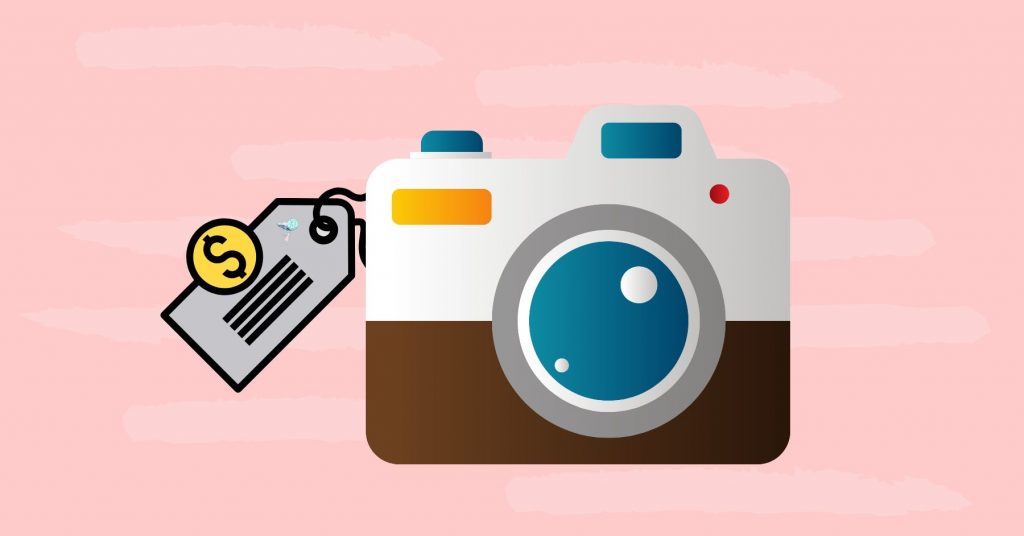
5. Fujifilm X-T4

The Fujifilm X-T4 is an APS-C sensor camera like the Sony a6400 and the Sony a6600 in this article. Although Fujifilm has not always been known for producing cameras for video work, this is definitely one worth looking into as it improves on many of the features that made the Fujifilm X-T3 so popular.
It comes with some really incredible video recording modes, especially on the slow-motion side. For slow motion frame rates, you can shoot at 60 FPS in 4k, 2k, and 1080p and record internally at 10-bit 4:2:0, which is crazy considering the price point it is at.
You will also find a High-Speed Record mode in this camera which will allow you to capture slow-motion footage up to 240 FPS at 50-200 Mb/s versus the 60-100 Mb/s that you find on the Sony cameras. Again, pretty amazing and is the slowest frame rate that you’ll find in all the cameras in this article.
What really makes this camera special, though, is its film simulation modes that allow you to emulate classic Fujifilm film stocks like Provia, Velvia, and Eterna with just a click of a button.
With that said at its current price point, it might make more sense to spend just a little more for the Panasonic S5. I say this as the Panasonic S5 is a full-frame camera with an even better set of frame rate options.
PROS
- Amazing high-quality slow motion video recording modes such as 60 FPS in 4k recorded internally at 10-bit 4:2:0.
- High-Speed Record mode available that allows you to shoot up to 240 FPS at 50-200 Mb/s.
- A wide selection of unique film simulation modes that emulates some of Fujifilm’s most popular film stocks.
- Improves on the popular Fujifilm X-T3 with double the battery life and in-body image stabilization.
CONS
- The autofocus system is not as good as the Sony cameras.
- There is a 1.2x crop when shooting 60 FPS in 4k and 1.3x crop when shooting in the High Frame Rate mode in 1080p such as 240 FPS.
6. Blackmagic Design Pocket Cinema Camera

The Blackmagic Design Pocket Cinema Camera is one of the most powerful video specific cameras available. It’s so famous for what it can do with video that many people call it the poor person’s Red Cinema Camera.
What makes this camera powerful for shooting video is the different codecs you can shoot in. In particular, you have the flexibility to record in 4 different versions of ProRes 422 or Blackmagic Raw codec all in the camera.

Without getting into the technical details, both these codecs are professional level and allow you to capture the most information possible in your video.
This gives you much more flexibility if you plan to color grade or color correct using a video editing software in post-production. In all other cameras in this price range, recording in ProRes 422 or a Raw format is only possible if you record externally to a video recorder.
In terms of slow-motion video, here are all the options you have. It’s pretty incredible and is the only camera in this article that can shoot 4k at 120 FPS.

PROS
- A super-powerful video camera that allows you to shoot ProRes 422 and Blackmagic Raw codec directly in the camera.
- The only 4k 120 FPS camera in this article.
- A huge amount of different slow motion frame rates available in different codecs.
- Very flexible dynamic range and performs incredibly well in low light situations.
- Wide variety of lenses available at different price points as its a Micro Four Thirds camera.
CONS
- You will need to get additional accessories such as external memory, rig, external monitor, and external batteries in order to really maximize the potential of this camera.
- It is solely for video so if you had plans to use your camera for both video and photography, this is not a good choice.
- There is no image stabilization and the autofocus is not very good.
- You will need a ton of storage to hold the ProRes 422 and Blackmagic Raw video files.
- It is a Micro Four Thirds sensor versus the APS-C and full-frame sensor cameras in this article.
- Almost 2x crop when shooting in 120 FPS.
7. Panasonic GH5

The Panasonic’s GH5 is a mirrorless Micro Four Thirds that is also jam-packed full of video features. It is easily one of the most advanced video cameras you can buy in this price range.
Most importantly, unlike the Blackmagic Design Pocket Cinema Camera, you can just pick this camera up and go out and shoot without the need for additional accessories.
On the slow-motion side, it can record at 60 FPS in 4k and up to 180 FPS at 1080p in 8-bit. You also have the flexibility to shoot 60 FPS 10-bit 4:2:2 in 1080p if you know you will be color grading your footage in post-production and you want to capture as much color depth as possible.

The camera has one of the best fully articulating flip touch screens that is easy to use even if you’re shooting outside in the middle of the day. This is especially apparent when you compare it to the screen on the Sony cameras, which aren’t the easiest to shoot with.
The downside of this camera is that the low-light ability and autofocus system are not as good as what you find on the Sony cameras.
PROS
- The video quality is one of the best and you can shoot at slow motion frame rates like 60 FPS at 4k and 180 FPS in 1080p.
- You can record in high-quality 10-bit 4:2:2 which will give you increased flexibility in post-production.
- The only camera in this article with a flip touch screen that fully articulates in all directions.
- One of the best in body image stabilizations available, which will allow you to easily capture smooth footage.
- Good value as you would expect to find these features in a much more expensive camera.
CONS
- Low-light performance is not as good as the Sony A7 III.
- Panasonic’s Depth from Defocus (DFD) autofocus system does not work as well as the contrast-detect and phase-detect autofocus system on the Sony cameras.
- It is a Micro Four Thirds sensor versus the APS-C and full-frame sensor cameras in this article.
- You cannot use autofocus in its Variable Frame Rate (VFR) mode, which means no autofocus at 120 FPS or 180 FPS.
8. Sony a6600

The Sony a6600 is also in Sony’s line of APS-C cameras and improves on what makes the Sony a6400 such a popular camera for video work. If you liked what you have read about the Sony a6400, the Sony a6600 might be a good fit if you have the budget and want the improved feature set.
The biggest changes they made to the Sony a6600 vs the Sony a6400 include:
- Upgrading to the Sony Z battery, which is the same battery you find in the full-frame Sony cameras and doubles your battery life.
- Has built-in 5-axis image stabilization.
- Only Sony APS-C camera with real-time eye autofocus in video mode.
For the slow motion frame rates, this camera, unfortunately, shoots at the same 60 FPS and 120 FPS at 1080p found in the Sony a6400. However, with the Sony a6600, you also get built-in 5-axis stabilization which will make it much easier for you to capture smooth footage. It’s also the only camera in Sony’s APS-C line of cameras that has stabilization.
With the new battery, 5-axis image stabilization, and real-time eye autofocus in video mode, it really makes this one of the best mid-range slow-motion cameras for any situation.
PROS
- Improved battery life, autofocus, and screen make this an even stronger camera than the already good Sony a6400.
- It has the great low-light performance that you can expect from Sony cameras.
- Quick and accurate autofocus system which now includes eye and face detection and object tracking.
- Pretty good autofocus when shooting in slow motion frame rates.
CONS
- You don’t have as flexible of slow motion frame rates as other cameras in the mid-range category.
- It records video in 8-bit versus the 10-bit that you will find in the cheaper Panasonic GH5.
- It is the most expensive mid-range option but doesn’t have the most features.
- The 5-axis in-body image stabilization is not as good as the Panasonic GH5.
Best Premium Slow Motion Cameras

9. Sony a7 III

Notes From The Field: Sony recently released the Sony a7C. The camera is a more compact and simplified version of the Sony a7 III and comes with nearly identical technical specs as the Sony a7 III. There are a few upgrades including better color science, a fully articulating flip out screen, and no 4k recording limit. On the other hand, there are some negatives with the Sony a7C to keep in mind too including lack of dual card slots, less customizable buttons, no joystick to move the autofocus point, and it may be harder to hold if you have bigger hands. Additionally, the current list price puts it only slightly cheaper than the a7III. With that said, if you like what you see with the Sony a7 III, and would benefit from no 4k recording limit and a fully articulating screen, it may be worth looking into the Sony a7C.
The Sony a7 III is one of Sony’s most popular full-frame cameras for both video and photography work. At its price point, it is also one of the best value full-frame cameras available in the market today.
What I will say is that if you’re strictly looking for a camera to shoot slow-motion video with, there are better choices like the Panasonic GH5, Fujifilm X-T4, or even the Sony a6600 if you want a Sony camera. For slow-motion frame rates, the specs on this camera remain similar to the Sony a6600 and older Sony a6500. It can shoot 60 FPS and 120 FPS in 1080p with an 8-bit bit depth.

However, if you’re also going to shoot 4k video, and maybe dabble with photography in addition to shooting slow-motion video, this is one of the best cameras you can get.
This camera has a full-frame sensor, which will give you better low light performance and greater depth of field. It has an incredibly accurate and fast autofocus system, and you have a variety of different customizable buttons on the body of the camera which makes switching between settings super quick.
PROS
- Full-frame sensor so you get a better low light performance and greater depth of field.
- There is no crop when shooting in slow motion frame rates like 120 FPS.
- One of the best, if not the best low light performance which will allow you to capture great quality video even in dark conditions.
- Ability to switch between full-frame and Super 35mm mode with a click of a button, which will allow you to zoom in 1.5x without losing quality.
- Incredibly powerful and accurate autofocus system which now includes eye and face detection and object tracking.
- Pretty good autofocus when shooting in slow motion frame rates.
CONS
- The slow-motion video quality and features on the Panasonic GH5 and Fujifilm X-T3 are better.
- At this price point, it might not make sense if you will strictly be shooting slow-motion video.
- The 5-axis in-body image stabilization is not as good as the Panasonic GH5.
10. Panasonic S5

The Panasonic S5 is the newest full-frame camera from Panasonic that takes all the goodness from the Panasonic GH5 which made it so popular with video shooters and makes it even better in all aspects in a full-frame sensor format. Most importantly, the autofocus tracking works up to 150 FPS which is a significant improvement over the GH5 which doesn’t have autofocus at 120 FPS.
Additionally, the autofocus system in the S5 is the newest and best offering from Panasonic to date and is better than what you find in the Panasonic GH5 and Panasonic G9 (which we go into detail below). With that said, the Panasonic depth from defocus autofocus system is still not as good as what you find in the Sony cameras.
For slow-motion video, you’re able to shoot in 4K UHD at up to 60 FPS in 10 bit (4k UHD 10 bit 4:2:2 if shooting up to 30 FPS) and in Full HD at up to 180 FPS in 10 bit as well. Just to give you a quick comparison, the Sony a7 III can only shoot in 4k at up to 30 FPS in 8 bit and in 1080p up to 120 FPS in 8 bit as well.
Also, if you’re ever shooting a film or have a commercial project, you can also output your video to an external recorder for even higher quality video codecs such as RAW 5.9k in 12 bit 4:2:2 at up to 30 FPS and RAW S35 DCI 4K at up to 60 FPS in 12-bit 4:2:2.
Similar to the other Panasonic cameras, you also get a fully articulating screen that is crisp and clear even in daylight conditions, and the S5 also has of the best IBIS (In Body Image Stabilization) systems that you will find.
Unfortunately, there is an APS-C crop when shooting in 4K at 60 FPS, but an APS-C crop is still better than what is available in the other cameras.
PROS:
- You have the flexibility to shoot at a wide range of high-quality video frame rates such as 4K UHD up to 60 FPS and 1080p up to 180 FPS.
- There is no record limit when you’re shooting in 4K with an 8-bit bit depth.
- The S5 is a full-frame camera which means it has better low light performance and you have more flexibility when cropping in (for example the camera has an APS-C size crop when shooting in 4k 60 FPS.
- It comes with V-Log picture profile which you had to pay for with the Panasonic S1.
- Very good IBIS system.
- You have the ability to record in 4k 10-bit 4:2:2 which will give you better video quality than the 8-bit codec found in other cameras such as the Sony a7 III.
- Has Panasonic’s newest autofocus offering and is improved when compared to the GH5 or G9.
- Impressive ergonomics with a bunch of customizable buttons and a joystick-like the Sony a7 III
- A flip touch screen that fully articulates in all directions that is similar to the Panasonic GH5 and Panasonic G9.
- Dual media card slots. This means you can simultaneously record to two different SD cards providing a backup to your footage or you can use it for extra memory capacity.
- Very good value at its current price point considering all of its video-specific features.
CONS:
- Panasonic’s Depth from Defocus (DFD) autofocus system still doesn’t work as well as the contrast-detect and phase-detect autofocus system on the Sony a7 III.
Important Information to Consider Before Buying a Slow-Motion Camera

What’s Your Budget?

The first thing you’ll need to understand is your budget. When setting your budget, keep in mind that for the most part there are two different types of cameras to choose from. Interchangeable lens cameras and fixed lens cameras.
Interchangeable lens cameras are awesome because they give you the flexibility to switch between different lenses which will give your image an entirely new look. However, the downside is that they’re usually more expensive as you will have to buy both a camera body and a lens (this isn’t always the case, though).
On the other hand, with fixed lens cameras, you don’t have the same flexibility, however, they’re usually cheaper and can give you many of the same powerful slow-motion features as interchangeable lens cameras.
You should also keep in mind that most of the interchangeable lens cameras that we will go over are made for both photography and videography.
For example, the full-frame Sony a7 III is in the premium category. The reason why it’s in the premium category is that it has great features that will benefit both photography and videography, but when it comes to just slow-motion specs, it is pretty much the same as the much cheaper Sony a6600, APS-C camera.
What’s the Best Affordable Slow Motion Camera
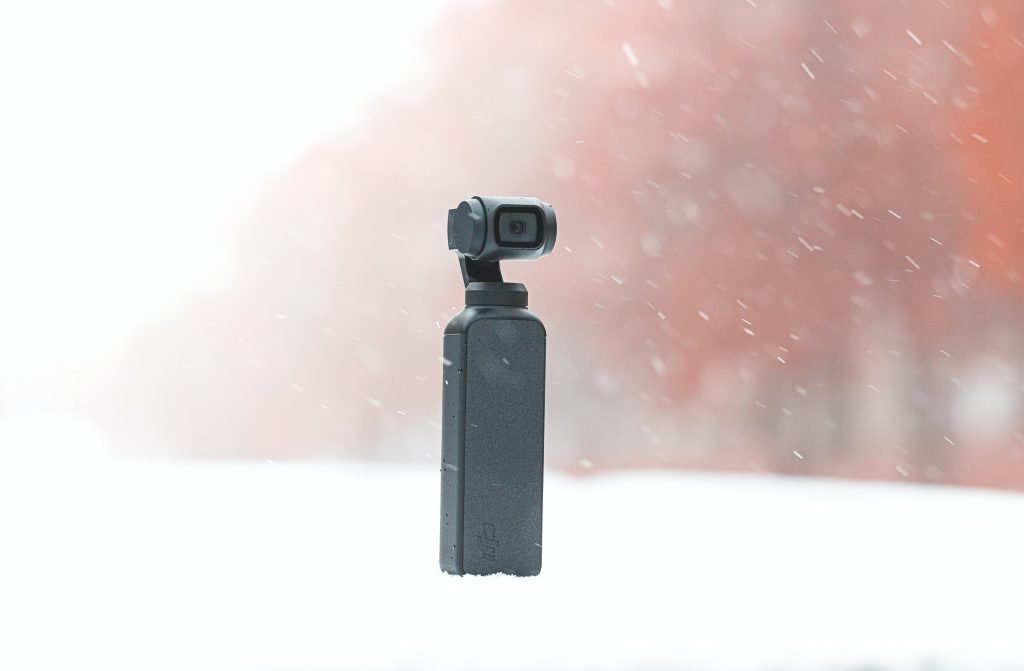
If you want to go with the cheapest slow-motion camera option, an action camera like the GoPro Hero9 or the DJI Pocket 2 is your best bet. You can find both of these for under $400.
Although these cameras are small and are more of an action camera, they are both jam-packed with powerful slow-motion features and will give you great video quality.
For example, both cameras are able to shoot 60 frames per second (FPS) at 4k, which many of the higher-priced interchangeable lens cameras we will go over don’t even have.
If you want a little bit more flexibility, you could go with the Sony RX100 VII. This powerful compact camera from Sony has a crazy zoom lens with a focal length range of 24-200mm. It also features the same autofocus system as Sony’s top of the line a9, and it can shoot 1080p at up to 960 frames per second (FPS).
Importance of What You’ll Be Filming

Each one of you will be using this camera to shoot slow motion and share it through different platforms.
It’s good to understand what each platform does when you upload the video. For example, if you’re primarily focused on sharing your videos through Instagram, Instagram does not support 4k videos. So, paying a premium to get a slow-motion camera that can shoot 60 frames per second (FPS) or slower at 4k might not make the most sense.
At the same time, you might be shooting these videos just for fun and sharing the videos casually with family or friends. If this is the case, you probably don’t need the latest and greatest camera model. The most important features for you might be ease of use and whether or not you need editing software to view the slow-motion video.
On the other hand, if you’re a professional filmmaker or you aspire to be a professional filmmaker, you will probably benefit from advanced features such as flat picture profiles, customization options, and a higher recording bit rate for better video quality.
Understanding how you will be shooting and sharing before making your final decision will save you time, frustration, and most importantly you’re hard-earned money.
How Bit Rate and Bit Depth Affect Video Quality

When you’re shopping for your slow-motion camera, you’ll notice that each camera will have a different bit rate listed. At the most basic level, the bit rate is the amount of information that is encoded per second. The important part to remember is that generally speaking, the higher the bit rate of your video, the higher the quality of your video. The bit rate is shown as the number of megabits per second.
This is the video specs for the Sony a6400 from B and H. As you can see in the yellow highlights, the bit rate is listed for every recording mode on the camera:

The video resolution and bit rate are separate from each other.
You can have two different cameras recording at 4k, but end up with different quality because of the bit rate it shoots at. For example, with all other variables being equal, if there are two cameras shooting in 4k resolution, the camera which records at a higher bit rate will have a better quality video.
There are some pros and cons of having a higher or lower bit rate. Higher bit rates, give you better quality video, but the file size is much larger, making it more difficult to store, upload, and send.
On the other hand, lower bit rates have lesser video quality, but the file sizes are smaller making it much easier to store and send.
Bit Depth Explained
In the video specs of each camera, you’ll also notice that some cameras can record in 10-bit versus 8-bit. This is the bit depth the camera can record in at the different recording modes. If you don’t see the bit depth listed, it is more than likely 8-bit as that is typically standard.
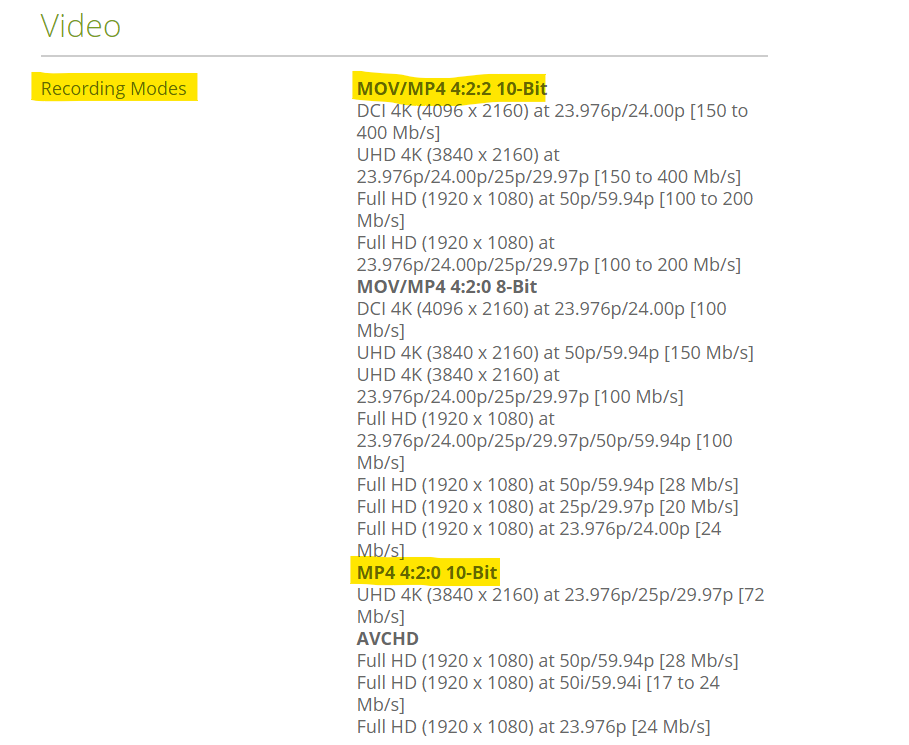
I’m not going to get into all technicalities of bit depth, but on a basic level, bit depth is the possible number of variations in shades of colors that make up an image. With an 8-bit bit depth, you can have a possible 256 shades of red, 256 shades of blue, and 256 shades of green. This gives you a potential 16,777,216 total colors in an image.
On the other hand, with a 10-bit bit depth, you can have a possible 1,024 shades of red, 1,024 shades of blue, and 1,024 shades of green in an image. This gives you a potential of 1,073,741,824 total colors in an image, so the difference between 8-bit and 10-bit is very significant.

To really take advantage of a 10-bit bit depth, though, you’re going to need to shoot in a log or very flat picture profile. You’ll also need to use video editing software like Adobe Premiere Pro or DaVinci Resolve to color grade your video in post-processing.
If you don’t plan on doing either, then an 8-bit bit depth is all you need.
Features and Attributes to Look for in a Slow Motion Camera
When choosing a camera to shoot slow-motion video, these are the most important features and attributes to look out for.

Size of the Camera Sensor

There are pros and cons of having a larger full-frame sensor versus the smaller APS-C, Micro Four Thirds, and 1/2.3” sensor size. For the most part, the larger full-frame sensors will give you better low light performance and will give you a greater depth of field at the wider apertures.
However, full-frame cameras and lenses are usually more expensive, bulkier, and heavier to carry around.
In reality, with the camera technology we have today, you can make amazing, cinematic videos with any sensor size. For example, I shot Spirit of Matsu, my first award-winning short film with the Sony a6500, which is an APS-C sensor camera.
Every slow motion scene you see here was shot with this camera and it is not even close to the most advanced camera or the newest anymore.
Slow Motion Frame Rates in 4K Resolution

Typically, the standard slow motion frame rates that you will find in cameras today are 60 frames per second (FPS), and 120 FPS. Some cameras might also have 100 FPS, 180 FPS, and even High Frame Rate (HFR) modes like 480 FPS and 960 FPS available.
In most cameras, the slow-motion frame rates will be shot in 1080p resolution. However, some cameras now have the ability to shoot slow motion in 4k resolution, which will give you significantly better quality slow-motion footage.
At this time, a slow-motion frame rate of 120 FPS in 4k resolution is the best slow-motion resolution you will be able to find in a consumer/prosumer level camera. The only camera we will cover in this article with the ability to shoot 120 frames per second (FPS) in 4k is the Blackmagic Design Pocket Cinema Camera.
Other cameras that we will cover like the Panasonic GH5, Panasonic S5, GoPro Hero9, DJI Pocket 2, and Fujifilm X-T4 still are able to shoot at 60 FPS in 4k resolution which will still give you a great slow-motion look to your footage.
Extreme High Frame Rates (HFR) Modes

In some cameras like the Sony RX100 VII, you have the ability to shoot in extreme High Frame Rate modes which turns these into super slow-motion cameras. Using the HFR mode, you will be able to capture extremely high frame rates like 240 FPS, 480 FPS, and even 960 FPS.
The downside with these extreme High Frame Rate (HFR) modes is that video quality is usually decreased and you can only record for a very short amount of time before the camera has to buffer.
Slow and Quick Modes

Some cameras like the Sony cameras have a Slow and Quick mode that allows you to shoot and process slow-motion footage in-camera. This means the slow-motion footage is ready to go right after you shoot it.
You’ll be able to preview your slow-motion footage through playback on the camera and you won’t need to slow down the video in post-production before using it.
The downside with any Slow and Quick mode is that the video is usually shot at a lower bit rate and you will lose flexibility when editing the footage.

